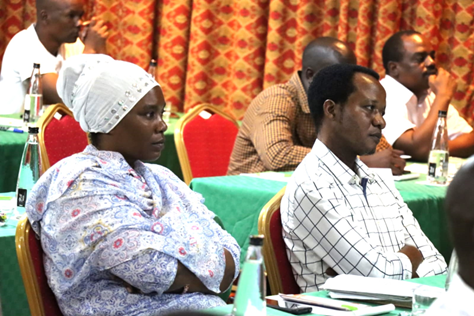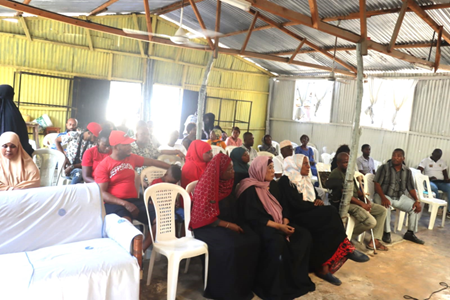Cultural Fusion and Resilience: Urban Refugees from Congo and Rwanda Find Home in Mombasa
Cultural Fusion and Resilience: Urban Refugees from Congo and Rwanda Find Home in Mombasa
By: Dominic Kabiru - Head of Public Affairs and Communication- KNCHR
In the bustling coastal city of Mombasa, where the Indian Ocean breeze meets the vibrant pulse of daily life, a unique story unfolds. Urban refugees from the Democratic Republic of Congo (DRC) and Rwanda have found themselves calling Mombasa home, specifically in the neighborhoods of Changamwe and Kisauni. Beyond the scenic coastal landscapes and historic landmarks, their narratives are woven into the fabric of Mombasa's urban life, marked by economic, social and cultural challenges, alongside the heartwarming stories of integration by the host communities.

Juvenare Miriam L (left) a refugee from Rwanda who has been in Kenya for 28 years as a refugee is joined by Eugene Lubanga from Congo (right) as they keenly listen to the KNCHR presentations on the Haki na Ushirikiano Project. They are both based in Mombasa.(Photo: Courtesy- KNCHR Public Affairs & Communication Division)
The Economic Struggle
For many urban refugees, economic survival is a daily pursuit. In the lively markets of Changamwe, where the vibrant colors of fresh produce blend with the echoes of haggling, refugees from Congo, Rwanda and other countries navigate the complexities of establishing livelihoods. Limited access to formal employment opportunities often compels them to explore entrepreneurial endeavors. Small businesses, such as market stalls selling traditional crafts, clothing and food, emerge as a testament to their resilience in the face of economic adversity.
The economic challenges are exacerbated by barriers to education and professional development, limiting refugees' access to higher-paying job opportunities. Despite these hurdles, stories of determination and resourcefulness abound as refugees leverage their skills to contribute meaningfully to the local economy.
Social Bonds Amidst Diversity
In the maze-like streets of Kisauni specifically in Bamburi area, where communities intertwine with the diverse backgrounds, social connections are formed. The challenges faced by urban refugees are not borne alone; rather, they are met with a spirit of communal support. The host communities, embracing the rich cultural diversity introduced by the newcomers, have played a pivotal role in fostering a sense of belonging.
In a makeshift iron sheet Church in Bamburi named - Shalom Temple Church run by a Congolese refugee Eugene Lubanga (He has been in Kenya for the last 27 years); adults and children from host communities and refugee families’ commune together. In other communal spaces near the Changamwe Social Hall children from refugee families born in Mombasa, kick paper-made soccer balls and engage in spirited games with their hosts, breaking down cultural barriers through shared laughter.

Eugene Lubanga (left) a refugee from Congo and the patron of Shalom Temple Church talking to the media crew in Mombasa on his 27 year journey as a refugee in Kenya.(Photo: Courtesy- KNCHR Public Affairs & Communication Division)
Cultural Adaptation
Congo and Rwanda, nations with unique cultural identities, find themselves transplanted into the coastal melting pot of Mombasa. From the vibrant Congolese rumba rhythms of Gospel music that echo from Lubanga’s worship house through the narrow alleys of Bamburi, one witnesses and experiences the cultural adaptation that embodies the spirit of unity in diversity.
Educational Hurdles and Triumphs
In the educational landscape of Changamwe and Kisauni, refugee children face both challenges and triumphs. The barriers to accessing quality education and limited resources pose significant hurdles. However, the resilience of the refugee families, coupled with initiatives by the Department of Refugee Services, Refugee Consortium of Kenya and local community leaders like Mr. Walter Andati from the Nyumba Kumi formation in Changamwe, has resulted in manageable integration.
The Role of Local Initiatives
Local initiatives, spearheaded by government agencies and community leaders have played a crucial role in facilitating the integration of urban refugees in Mombasa. Collaborative efforts between these organizations and the host communities have also resulted in initiatives not only to address immediate needs of the refugees; but also contribute to the long-term social cohesion between refugees and their host communities.

Refugees and host communities in Kasauni gather at Lubanga’s Shalom Temple Church to listen to KNCHR team on the tenets of the rights and integration of refugees and host communities’ project.(Photo: Courtesy- KNCHR Public Affairs & Communication Division)
A Vision for the Future
As the sun sets over the horizon of Mombasa, casting a warm glow over Changamwe and Kisauni, the stories of urban refugees from Congo, Rwanda and other recorded countries continue to unfold. The economic, social and cultural challenges are met with resilience, determination and the spirit of unity that characterizes the coastal city. The fusion of cultures, the bonds formed in adversity, and the collaborative efforts of host communities paint a picture of hope and progress.
In the ever-evolving narrative of Mombasa's urban refugees, there lies a vision for the future - a future where economic opportunities are equitable, social bonds continue to strengthen, and cultural diversity is celebrated as an intrinsic part of the city's identity. In this vision, Mombasa emerges not just as a city of historical significance but as a vibrant, inclusive home for all who seek refuge within its embrace.
Kenya National Commission on Human Rights is proud to be associated in this venture and project of refugees and host communities’ integration in Kenya.